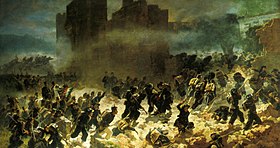| Capture of Rome | |||||||||
|---|---|---|---|---|---|---|---|---|---|
| Part of the unification of Italy | |||||||||
 Breach of Porta Pia, by Carlo Ademollo (1880) | |||||||||
| |||||||||
| Belligerents | |||||||||
|
|
| ||||||||
| Commanders and leaders | |||||||||
| Strength | |||||||||
| 50,000 | 13,157 | ||||||||
| Casualties and losses | |||||||||
|
49 killed 132 wounded[1] |
19 killed 68 wounded[1] | ||||||||
 |
| This article is part of a series on |
| Vatican City |
|---|
The Capture of Rome (Italian: Presa di Roma) occurred on 20 September 1870, as forces of the Kingdom of Italy took control of the city and of the Papal States. After a plebiscite held on 2 October 1870, Rome was officially made capital of Italy on 3 February 1871, completing the unification of Italy (Risorgimento).
The capture of Rome by the Royal Italian Army brought an end to the Papal States, which had existed since the Donation of Pepin in 756, along with the temporal power of the Holy See, and led to the establishment of Rome as the capital of unified Italy. It is widely commemorated in Italy, especially in cathedral cities, by naming streets for the date: Via XX Settembre (spoken form: "Via Venti Settembre").